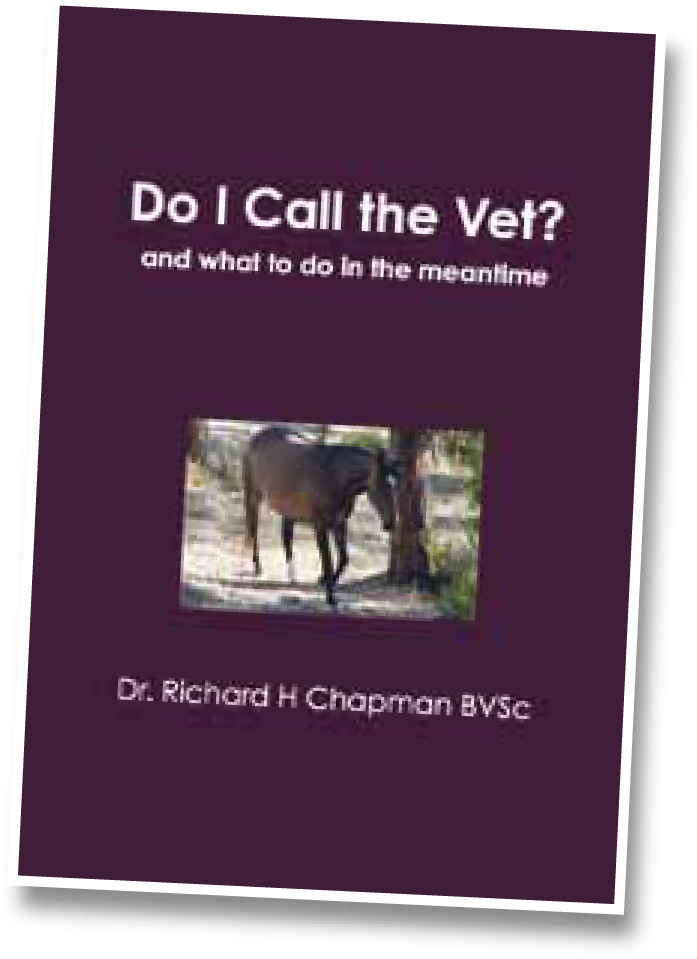Do I call the vet? and what to do in the meantime

Do I call the vet? and what to do in the meantime is written by Dr Richard Chapman BVSc. The slim book/manual was written in response to requests from the author's clients to produce the manual which includes explanations and understanding of animals and the illnesses, accidents and ailments which can occur, and how to treat them. The book is published by Touchworks Ltd and solely aimed at pet owners to help them answer ‘Do I need to call a vet or can I possibly treat this myself with guidance from Richard's book’.
Richard must surely be one of our longest practicing vets. He is now 80 years old, having been in mainly equine and large animal veterinary practice since he qualified at Bristol University in 1958. Most of his professional life has been based in Australia, as explained in the ‘About the Author’ and in the ‘Foreword’ sections of the book.
Dr Richard Chapman has included his 57 years of experience as a veterinary surgeon in a synergistic approach to treating animals. He uses his wisdom, experience and understanding of holistic treatment, and mainly treats animals the ‘old fashioned way’. After reading the book it is clear that this is the correct way to explain his intervention with animals and I found it a very interesting read.
A disclaimer is included on the first page that the book is based on experience and does not replace consultation or advice from a veterinary surgeon. There is also a brief introduction to Dr Richard Chapman and his working life as a veterinary surgeon, and it is clearly evident while reading this that his experience is vast and fully supports the idea behind the book.
The book is split into two main sections the first part is on horses and has 13 small chapters with common abnormalities that can present with alternative treatment suggestions. The second part of the book is aimed at cats and dogs and also includes 13 sections. It is written in a very easy to read, owner friendly, chatty format with a brief explanation of the subject area, problems that may occur and suggested home treatments including whether or not veterinary consultation is required. There are occasional photos throughout the book to ensure the owners have an image to refer to as well. Both sections provide information, reassurance, helpful tips and first aid measures for the particular subject area.
The main sections for horses, dogs and cats include mini chapters titled, feeding and diet advice, mouth and dentistry, alimentary problems, coughs and colds, eyes and ears, laminitis (for horses), house training (dogs and cats), hormonal conditions, musculoskeletal conditions, restraints, skin, wounds and other conditions (horses).
An example of a suggested regimen for home treatment of diarrhoea for dogs includes the ‘5 day diet’, broken down into days for the owners ease of understanding with instructions on what to feed and frequency. It also does explain the importance of contacting your vet and the common problems that may present with diarrhoea such as dehydration. This is still a successful treatment regimen which is still recommended and used in veterinary practice today.
At the end of the book there are appendices, which include a very interesting useful guide for owners with holistic and alternate homeopathic recipes for minor ailments.
I found the book very interesting and I was surprised at his no nonsense approach to some of the suggested treatment advice for owners to implement, however the author has documented his experience of success with these treatments and I feel that it could be the ‘missing part’ of conventional veterinary treatments used in veterinary practice today.
The book's website can be found at www.richardchapman.vet
A coil-bound print of the book can be obtained from lulu.com at the following link:
http://www.lulu.com/shop/dr-richard-h-chapman-bvsc/do-i-call-the-vet/paper-back/product-22560631.html
An e-book version is available, also from lulu.com, at this link: http://www.lulu.com/shop/dr-richard-h-chapman-bvsc/do-i-call-the-vet/ebook/product-22560635.html
Both paperback (but not wire-bound) and e-book versions are also available from www.amazon.co.uk and from https://www.amazon.com.au/

